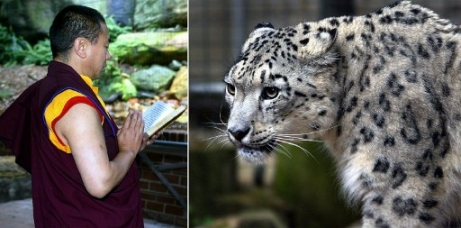A secret weapon in the battle to save the snow leopard?
by K.M. | BEIJING
 Do they have a prayer?
Do they have a prayer?The research, led by Juan Li of Peking University and sponsored by the wildcat protection group Panthera, focused on the snow leopard's habitat on the Sanjiangyuan Nature Reserve, a 360,000 sq km area in north-western China that holds the headwaters of the Mekong, Yellow and Yangzte Rivers. Researchers found that the region's more than 300 Tibetan monasteries lie close to important snow leopard habitats, and that monks are critical to protecting the cats. About 4,000 snow leopards remain in China, most living in the Sanjiangyuan region.
"Monks on the Tibetan plateau serve as de facto wildlife guardians," Panthera said in a news release about the study. "Tibetan Buddhism considers the snow leopard and its habitats strictly sacred, and the monks patrol wild landscapes surrounding monasteries to enforce strict edicts against killing wildlife."
Until recently Tibet had a thriving trade in wild animal skins. Tiger and leopard skins featured prominently in clothing. Monks were not allowed to kill animals, but they wore the skins. In January 2006 Tibet's spiritual leader, the Dalai Lama, put an end to all that, calling on Tibetans to stop buying, selling and wearing wild animal skins. The displays, he said, were counter to Buddhist principles and within weeks Tibetans were burning tiger skins in the streets and the trade was halted.
Today, conservationists say, land near monasteries provides safe haven and cats tend to stay in close proximity. The monks' habit of sheltering stray dogs does present potential leopard threats in the form of disease, but the overall situation for snow leopards is better around monasteries than on nature reserves in China, Panthera found.
Other wildcat researchers not involved with the Panthera report agree there is a clear connection between religion and species survival: Buddhist monks will not intentionally kill the animals, creating a safety net on the Tibetan plateau.
Li Zhixing, head of a Chinese Siberian tiger protection organisation far across the country from Qinghai, said the endangered tigers are god-like to villagers in the northeastern corner of China they still inhabit. As a result, locals stopped poaching tigers decades ago. Wolves, meanwhile, suffered a different fate. They were considered evil and are, as a result, gone.
Monasteries make for natural protective grounds, but there is disagreement over whether Tibetan monks ought to be made guardians of the snow leopards and given funding or equipment, as Panthera recommends. Ma Ming, a research fellow in Xinjiang with the Chinese Academy of Sciences, said there is an obvious link between monasteries and safe space for leopards, but that does not mean Tibetan monks make the best game wardens.
Mr Ma argued that government programmes make the wisest use of funding, and that the Chinese government—as it has proven with giant pandas—can save a species if it wants. But as the Panthera study notes, official efforts can be hampered by the many county, provincial and national boundaries that run through snow leopard habitat areas.
In any case, the priority given pandas is still lacking for snow leopards, which compete for space and attention with other endangered species under threat from China's development and vast urbanisation. China has enacted new schemes in recent years to protect wild cats, including snow leopards and Siberian tigers. But these species remain at risk. Farmers are compensated for wildlife lost to wildcats and poaching is punished, but critical habitat is shrinking.
In the face of calls for greater protective efforts, Panthera says Tibetan monks have been doing all along what is required to protect snow leopards—leaving them alone.
(Photo credit: Greg Wood/AFP)








































































Come October, and season begins in Gir, the home of the fabulous Asiatic lion. Zerin Anklesaria was there recently and, thankfully, lived to tell the tale.